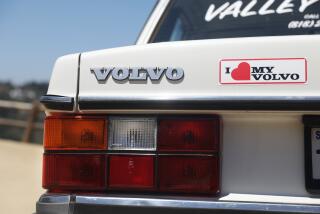The auto industry hits home for American families
- Share via
We baby-booming native Detroiters grew up with a ranking system. On the playgrounds at recess, GM was No. 1, Ford was No. 2, Chrysler was No. 3 and American Motors wasn’t really worth the effort it took to insult the poor kid whose dad worked there (sorry Mitt Romney). My dad worked for GM -- it all made sense to me.
I didn’t own a car until I moved to Los Angeles 10 years ago. Before that, my husband and I had lived in Chicago and we rode the El and the buses, an option that wasn’t as viable here. He moved to L.A. nine months before I did, and just before I arrived, he bought us a used car. It wasn’t exactly a “little old lady from Pasadena” situation -- it was a rusty, 1981 Chevy Citation -- but its provenance was single owner, a friend’s mom, and it had only 81,000 miles on it.
He picked me up at LAX in it, explaining its virtues, which were not exactly apparent as we drove north to our new home in Hollywood. “You need a broomstick to prop open the hatchback, and be careful when you use it because if that thing falls, it will snap your neck. And the windshield wipers turn on of their own volition every few hours, but other than that, it’s a V-6, and it’s built like a tank.”
Didn’t I know it. I’d helped build the prototype for that very car. This was back in 1976, when I worked for a summer at GM Plant 21 on the early version Citations (simply called the “X” car then) that would come out five years later. I was a runner. I moved up and down the line and looked at the list attached to the hood of the X-car where guys (it felt as if I were the only woman in the plant) made notes about missing pieces of chrome or molding. I ran to the central supply crib in the middle of the plant and fetched the missing pieces. For that I made $8 an hour -- and earned enough for room and board at the University of Michigan the next year. My parents paid my tuition.
Two years after he’d bought the Citation, my husband was driving it when a woman who was, in her own words, “high on yoga” ran a red light at 40 miles per hour and crashed into him on the driver’s side. He, as the saying goes, walked away from the crash unscratched. The Citation, just a midsize car, did its job. Who needs a $50,000 Hummer?
That’s part of the question, isn’t it? Who needed those Cadillac Escalades, those H2s, those Chevy Tahoes, gas guzzlers all, that never met a CAFE standard they wouldn’t rather miss by 5 miles per gallon? GM made cars and trucks whose engines almost seemed to hum, “Build ‘em bigger! Gas is cheap!” But just because people will buy it, does that mean it should be built? Where does the responsibility for one’s product line come into play?
GM Chief Executive Richard Wagoner, in a “NewsHour” interview with Judy Woodruff recently, said GM built those SUVs and trucks because that’s what customers demanded. What he didn’t add was that GM was up on Capitol Hill lobbying hard against raising CAFE standards. That’s a hell of an omission. It’s as if the American Dental Assn. asked Congress to pass laws that required parents to feed children three square meals of candy every day and then insisted that it bore no responsibility for the decay that followed.
But, of course, it’s still not that simple. The monster bad guy, GM, is really not all that evil. Not only does it directly employ 96,000 people, its 6,500 dealers employ another 340,000 people, and it does business with more than 2,000 suppliers in 46 states. It has provided blue-chip healthcare (including dental and vision) and modest pensions to its employees for the last 40-some years, meeting a responsibility that government has not yet stepped up to (and adding great cost to its cars). Who doesn’t want people to have decent wages and good healthcare coverage?
On Thursday, I called my parents, octogenarians now, to see what they thought about the hearings, the testimony of the Big Three CEO’s, the bailout. My dad came on first and bellowed, “It’s all crap!” I didn’t quite know what he meant by that, so I asked a specific question. Should they lend the money to GM? He yelled, “Yes! Lend the money and let’s get going and fix this thing! We’ll have 70 million unemployed immediately if they let it go under! They say it’s less, but I say it’s 70 million!” My mom felt the same way, though she didn’t bellow and her numbers were sound, and then she lowered her voice and told me that she’d moved a chunk of money out of GMAC, the financial services arm of General Motors (although no longer wholly owned by the company), where it had been parked for decades. “I feel awful that I did it. The company has been good to us, but we couldn’t take the risk.”
During the Senate hearings the other day, more than one senator, and an economist from the University of Maryland, argued that if GM, Ford and Chrysler declared bankruptcy, accepting a Chapter 11 reorganization plan whose underpinnings were laid and supported by the federal government, people would still buy their cars and would trust that the cars would be serviced and under warranty.
But let’s be realistic here. My mom and dad, whose loyalty to GM could make Lou Gehrig look like a Yankee traitor for retiring too young, moved their money out of GMAC. Do you really think the average American is going to buy a car from a company in Chapter 11? Toyota and Honda aren’t going anywhere, after all. We’ll have options.
When I asked my parents about the bailout, I didn’t expect an objective answer. I imagine they see GM in each of the six kids they raised, not to mention the grandkids who followed.
Multiply that by the millions of families linked to the Big Three today -- not just the direct employees but the people who work at the dealerships and those who work for the parts suppliers -- and you’ve got indelible red ink staining the books of businesses in every state. The disappearance of the automobile industry could kill the chances of all of these people to have a decent future.
That’s what the bailout supporters are fighting for, what they’re driving toward -- a decent future. Who can blame them for wanting to do so in an American-made car?
Ellen Slezak is the author of “All These Girls,” a novel, and “Last Year’s Jesus,” a collection of stories.
More to Read
A cure for the common opinion
Get thought-provoking perspectives with our weekly newsletter.
You may occasionally receive promotional content from the Los Angeles Times.










